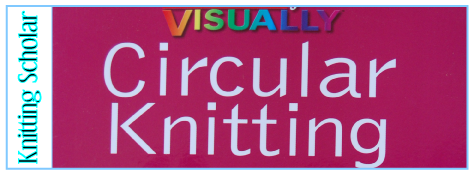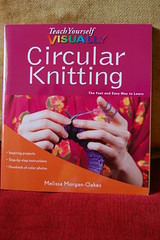First, the facts:
Title: Teach Yourself Visually: Circular Knitting
Author: Melissa Morgan-Oakes
Published by: Wiley, 2011
Pages: 256
Type: How-to
Chapters:
1. Introduction to Circular Knitting
2. Circular Knitting Methods
3. Special Techniques for Circular Knitting
4. Starter Projects
5. Planning a Project
6. Simple Projects
7. Intermediate Projects
8. Advanced Projects
9. Steeked Projects
10. Stitch Gallery
The In-Depth Look:
In the beginning, knitting was flat.
Well, not precisely. There have almost always been garments knit in the round–socks, mittens, and hats, for example. But they were small objects, knitted on double-pointed needles which are practical for something the size of a sock but not so much for a sweater for your burly husband. DPNs are not always beloved of knitters, either, which is why alternate methods have become so popular.
The point, though, is that not all that long ago it was a habit–especially of the publishing/fashion industry–to create knitted sweaters by making flat pieces and sewing them together. You just knitted the pieces to the correct dimensions and assembled. It was like sewing a blouse without having to buy yardage or get out the pinking shears.
There’s nothing wrong with that, of course, but since knitters can so easily make tubular objects, a lot of us prefer to knit things meant to fit our roundish human bodies in one piece. It’s not a new concept, either. Sweaters have been knit in the round for hundreds of years–it just took a while for the fashion industry to notice. Half a century ago, Elizabeth Zimmermann bemoaned the fact that she would submit patterns for circular-knit sweaters to magazines and they would convert them to flat-patterns before publishing them. With the enthusiastic help of talented, traditional knitters, though, little by little, circular knitting gained a foothold in the modern knitting world.
Which brings us to this book on circular knitting, the latest in the “Teach Yourself Visually” series, which focuses on knitting-in-the-round. That is, spiraling your way up a tube of fabric–whether it is a sock, a mitten, a hat, a sleeve, or a sweater–rather than knitting separate pieces and sewing them together.
Now, I’ll tell you that knitting in the round is my preferred knitting method, so I may be biased in that regard. (Okay, I am biased toward circular knitting.) But that doesn’t mean I’m not aware of its limitations … and neither is Melissa Morgan-Oakes, because she carefully tells you the pros and cons of this method.
Actually, she tells you all sorts of things! What kinds of needles to use (and how to pick among the many options). How to join the ends (along with tips on how to avoid twisting). How to work with color. How to pick a yarn. How to knit a gauge swatch. How to cut a steek. … There is lots of great detail in here.
There are also some patterns. Earwarmers, hats, mittens, sweaters–all fairly basic, straight-forward kinds of projects at differing skill levels. There are some stitch-patterns to play with, too.
Obviously, this book is geared toward newer knitters–like all of the “Teach Yourself Visually” books, the point here is to TEACH, and a lot of this might be old territory for long-time knitters. There’s a lot of information, though, so there’s likely to be new details for your average knitter. (Not that knitters are average.) The illustrations, not surprisingly, are good and clear as well, though occasionally on the small-side.
All in all, this is a good resource and could be very handy for relative beginners, and it’s available at Amazon.com.
Want to see bigger pictures? Click here.

This review copy was kindly donated courtesy of Jessalu on behalf of the author. Thank you! (In fact, head over to her blog today to read my interview with the author.)



Comments on this entry are closed.